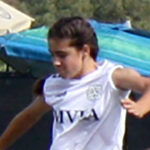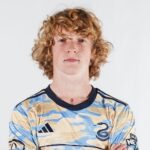Concussion roulette: Unload that gun
 Finally! Some attention for women soccer players and concussions! Briana Scurry’s surgery and recovery are front page news in the Washington Post.
Finally! Some attention for women soccer players and concussions! Briana Scurry’s surgery and recovery are front page news in the Washington Post.
The good news: Briana is experiencing relief from the concussion symptoms she has endured for several years. The bad news: We are still confused about what a concussion is.
Post reporter Caitlin Dewey writes, “Despite the recent surge in concussion awareness, researchers and doctors still know little about the exact mechanics of concussion. They understand the initial trauma, when the brain bumps up against the skull and begins to bleed or bruise. Less clear are … the effects downstream.”
NO! A concussion is NOT a bump of the brain against the skull. It is not a bruise. It is not a bleed. These can all be seen on CT scan. We cannot see concussions on medical scans. We can only experience them.
We keep preaching education and awareness. I’m completely on board. Let’s learn the symptoms so we can recognize the concussion. There are websites and apps out there which can help do this. Let’s do this. There are people who will sell us products which they propose to prevent concussions, but science does not support this.
Helmets do a good job of protecting our skulls; they just don’t do a good job of protecting our brains. For that, we’ve got be smarter.
A concussion is none of these. It’s a disconnection of circuitry. We can’t sew it back together. We have to rest it and wait patiently and hope that it reconnects.We need to learn what the injury is. Ms. Dewey, who has a three-page spread in the Post, has done a lot of research. But she has misunderstood what we — the doctors and researchers — know. Concussion is not an orthopedic injury. Sports folks are stuck here. Orthopedic injuries are breaks, tears, ruptures, dislocations.
Not until we understand the injury can we understand why it’s so hard to manage.
Let’s look at it this way: Imagine you have a lamp on an end table and it has a six-foot cord plugged into an outlet in the wall. Switch on the lamp and the lamp provides light. Suddenly, we have a small earthquake, a tremor. The room shakes, the end table tips, the lamp wobbles precariously and it goes out.
You look around. Thank goodness. The house still has power, but by the light of the overhead fixture you can see the disruption to the room. Books fallen. Plants toppled. Dishes broken on the floor. But the lamp, still on the table, has gone out. Why? Because its cord has been pulled from the wall outlet. Its connection has been disrupted. You plug it back in and it lights again.
That’s what concussion does. It pulls out the plug. And the location of that plug is different with each player and each concussion. We can’t see it. We just know that a light has dimmed or gone out. We have no way of plugging it back in. Mother Nature must do this for us.
What caused the disruption? The quake. Do all lamps go out? No. Do all plugs come unplugged? No. The ones who stay put:
- Are plugged in securely
- Are on a very sturdy table
- See the quake coming and brace for impact
- Invest in a seismograph
- Don’t live on a fault line
You see, if we really understand the nature of the injury, we can see what needs doing. We can work to protect our kids from coming unplugged. How?
- Make sure your players know what this injury is. (So they’ll be smart about resting.)
- Train for a stronger core, stronger upper body and strong postural muscles. Make them sit up at the table and sit up to do their homework.
- Train players to play the ball and not the player.
- Report teams that play dangerously, or refuse to play them.
- Quit soccer.
Of course, quitting soccer will not prevent concussions. Basketball and lacrosse are fast challenging soccer’s dominance in the risk realm. For now, we won’t discuss gridiron football. And incidental head bangs or body bumps are taking their toll as well.
Why? We, the doctors and researchers, are not sure. What we know is: we’re seeing more of them, younger players are more at risk, and players with a history of concussion increase their chances of sustaining another one.
Why? We’re working on this. The fact is: kids’ brains have many lamp cords and their plugs are not yet snug. Their lamps sit on precarious tables with spindly legs and narrow bases. We need to keep the lights on.
Sports today are nearing the epicenter of the quake. Blaming the refs for not keeping order, the leagues for not protecting kids and the legislatures for not regulating is not protecting our game or our kids. But watching videos, signing wavers, and learning rhymes and acronyms will not do it. We need to look at how we train and how we play. We need to change how we do business.
And competitive folks don’t do this lightly, but we can be reasonable. We just need a reason. Symptom recognition is not gonna do it. I don’t think we’ll act on the problem until we actually understand the injury. It’s not just a bump or bruise. It’s not even a simple break. It’s a disconnect in the wiring. And that’s a live wire. We’ve got to shut down the power running to it, so it can attend to repairing itself. Completely.
Yes, we CAN do something about the problem. We must correctly understand the injury to appreciate its magnitude. The big quakes take a while to clean up after. Then wise city planners rebuild their buildings with sturdier walls and stronger structural support. To resist future earthquakes. Because moving out of town is not an option. We live here.
SOCCERWIRE MARKETPLACE
- Wanted Licensed Youth Soccer Coach
- Join Official Elite Summer Soccer Camps with Europe’s Top Pro Clubs!
- The St. James FC Travel Staff Coach - North (Loudoun) & South (Fairfax)
- The St. James FC Girls Academy (GA) Head Coach - 2 teams
- The St James FC Boys Travel Tryouts
- OFFICIAL BAYERN MUNICH SUMMER CAMPS U.S.
- JOIN THE ALLIANCE!
- OFFICIAL FC BARCELONA CAMPS U.S.
- The Cup San Diego - Hosted by Legends FC
- Players Wanted - Undergraduate or Post-graduate













